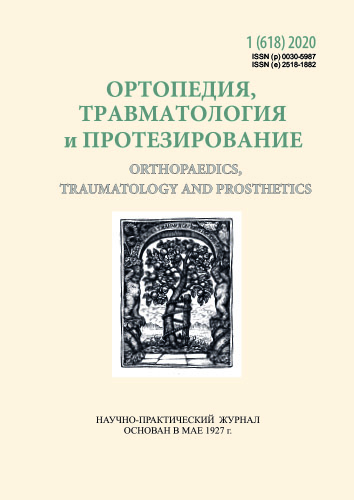Subacute compartment syndrome in case of gunshot injuries of the extremities
DOI:
https://doi.org/10.15674/0030-59872020115-19Keywords:
subacute compartment syndrome, local hypertensive ischemic syndrome, gunshot injuries of the extremitiesAbstract
A local hypertensive ischemic syndrome or compartment syndrome (CS) is a serious complication of gunshot injuries of the extremities (GIE), it is usually considered as an acute process. However, we have repeatedly observed patients with subacute course of this pathology.
Objective: to study cases of subacute CS (SaCS) with GIE, that are characterized by a latent course and veiled clinical picture of the complications.
Methods: there were 15 cases of subacute CS after gunshot injuries for the period 2014–2018. 9 (60 %) were combined injuries of trunk and limbs, 6 (40%) — isolated limb wounds. Lesions of the lower extremities predominated — 10 (66.6 %). In 8 (53.3 %) patients, SaCS developed after shrapnel wounds of the limbs, and in 5 (33.3 %) cases — mine-explosive. Results: in 9 (60 %) cases, SaCS was observed in the bone-fascial sheath of the damaged area of the limb, in 6 (40 %) — in the adjacent segment. In 10 (66.6 %) patients, the course of SaCS was preceded by major vessels injury, in 8 (53.3 %) cases — it was combined with peripheral nerves injuries. In 12 wounded at the stages of evacuation, a tourniquet was used for more than an hour. In 5 cases, the course of SaCS was observed in patients with a combined wound of two or more anatomical sites with the development of a shock or prolonged hypotension. The time from the moment of injury to secondary surgical treatment, when the morphological signs of existed local hypertensive ischemic syndrome in bone-fascial sheath were identified, was from 5 days to 3 weeks.
Conclusions: CS in case of GIE can have both acute and subacute flow patterns. SaCS usually develops in the intact segment of the injured limb without pronounced clinical manifestations. Risk factors for the course of SaCS: injuries of the main vessels, tourniquet for more than an hour, multilevel injuries with the development of a shock or prolonged hypotension, incomplete (untimely) fasciotomy at the evacuation stages.
References
- Emergency military surgery (trans. from English). (2015). Lviv: Nautilus. [in Ukrainian]
- Strafun, S. S., Brusko, A. T., & Lyabah, A. P. (2007). Prevention, diagnosis and treatment of ischemic contractures of the hand and foot. Kyiv: Stilos. [in Ukrainian]
- Gaiko, G. V., Strafun, S. S., & Burjanov, O. A. (2014). Compartment syndrome in gunshot wounds of the extremities; ed. A. P. Lyabach. Kyiv. [in Ukrainian]
- Cubano, M. A., Lenhart, M. K., & Bailey, J. A. (2013). Emergency war surgery. Fourth United State Revision. Office of the Surgeon General, Fort Sam Houston. Texas, Borden Institute
Downloads
How to Cite
Issue
Section
License
Copyright (c) 2020 Sergiy Strafun, Andriy Laksha, Volodymyr Shipunov, Natalia Borzykh, Oleksandr Strafun

This work is licensed under a Creative Commons Attribution 4.0 International License.
The authors retain the right of authorship of their manuscript and pass the journal the right of the first publication of this article, which automatically become available from the date of publication under the terms of Creative Commons Attribution License, which allows others to freely distribute the published manuscript with mandatory linking to authors of the original research and the first publication of this one in this journal.
Authors have the right to enter into a separate supplemental agreement on the additional non-exclusive distribution of manuscript in the form in which it was published by the journal (i.e. to put work in electronic storage of an institution or publish as a part of the book) while maintaining the reference to the first publication of the manuscript in this journal.
The editorial policy of the journal allows authors and encourages manuscript accommodation online (i.e. in storage of an institution or on the personal websites) as before submission of the manuscript to the editorial office, and during its editorial processing because it contributes to productive scientific discussion and positively affects the efficiency and dynamics of the published manuscript citation (see The Effect of Open Access).














